A prisoner in the Vatican or prisoner of the Vatican described the situation of the pope with respect to the Kingdom of Italy during the period from the capture of Rome by the Royal Italian Army on 20 September 1870 until the Lateran Treaty of 11 February 1929. Part of the process of the unification of Italy, the city's capture ended the millennium-old temporal rule of the popes over Central Italy and allowed Rome to be designated the capital of the new nation. Although the Italians did not occupy the territories of Vatican Hill delimited by the Leonine walls and offered the creation of a city-state in the area, the popes from Pius IX to Pius XI refused the proposal and described themselves as prisoners of the new Italian state.
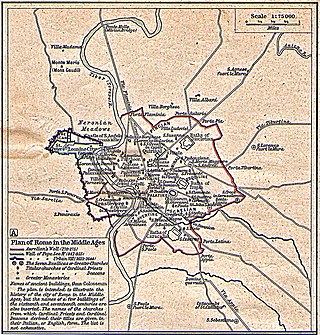
The Leonine City is the part of the city of Rome which, during the Middle Ages, was enclosed with the Leonine Wall, built by order of Pope Leo IV in the 9th century.

The Aurelian Walls are a line of city walls built between 271 AD and 275 AD in Rome, Italy, during the reign of the Roman Emperor Aurelian. They superseded the earlier Servian Wall built during the 4th century BC.

Borgo is the 14th rione of Rome, Italy. It is identified by the initials R. XIV and is included within Municipio I.

The Porta del Popolo, or Porta Flaminia, is a city gate of the Aurelian Walls of Rome that marks the border between Piazza del Popolo and Piazzale Flaminio.
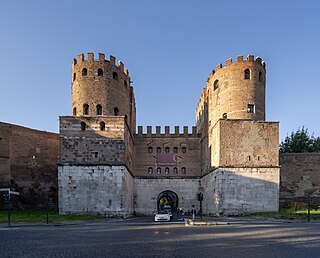
The Porta San Sebastiano is the largest and one of the best-preserved gates passing through the Aurelian Walls in Rome (Italy).
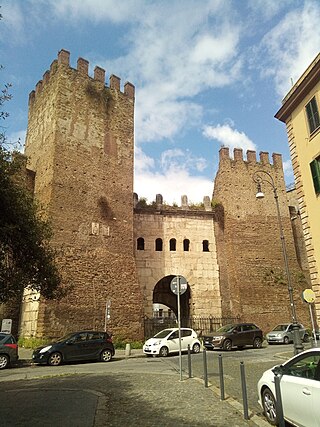
Porta Tiburtina or Porta San Lorenzo is a gate in the Aurelian Walls of Rome, Italy, through which the Via Tiburtina exits the city.
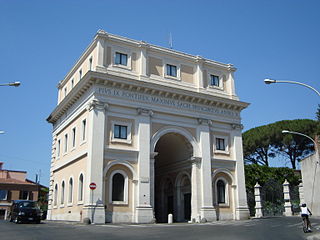
Porta San Pancrazio is one of the southern gates of the Aurelian walls in Rome, Italy.

Porta Portese is an ancient city gate, located at the end of Via Portuense, where it meets Via Porta Portese, about a block from the banks of the Tiber in the southern edge of the Rione Trastevere of Rome, Italy.

Porta San Giovanni is a gate in the Aurelian Wall of Rome, Italy, named after the nearby Archbasilica of Saint John Lateran.
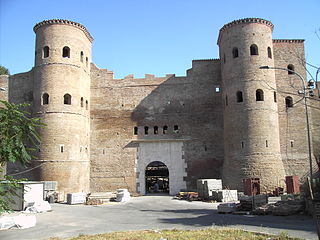
The Porta Asinaria is a gate in the Aurelian Walls of Rome. Dominated by two protruding tower blocks and associated guard rooms, it was built between 271 and 275 AD, at the same time as the Wall itself. Unlike most of the other gates, it was not rebuilt or fortified by Honorius or restored by Theodoric.

Porta Settimiana is one of the gates of the Aurelian walls in Rome, Italy. It rises at the northern vertex of the rough triangle traced by the town walls, built by Emperor Aurelian in the 3rd century, in the area of Trastevere and up through the Janiculum.

The Porta Nomentana was one of the gates in the Aurelian Walls of Rome, Italy. It is located along viale del Policlinico, around 70 m east of Porta Pia. It is now blocked and merely a boundary wall for the British Embassy.

Porta Santo Spirito is one of the gates of the Leonine walls in Rome (Italy). It rises on the back side of the Hospital of the same name, in Via dei Penitenzieri, close to the crossing with Piazza della Rovere.

The Janiculum walls are a stretch of defensive walls erected in 1643 by Pope Urban VIII as a completion of the Leonine wall and for a better protection of the area of Rome rising on the right bank of the Tiber.

Porta Angelica was a gate of the Leonine Wall in Rome (Italy).

Porta Pertusa is one of the gates of the Leonine Wall in Rome (Italy).

Porta Ardeatina was one of the gates of the Aurelian Walls in Rome (Italy). The gate was built in the time of Nero. It stands at an angle in the Aurelian Walls.

The Porta Viminale was a gateway in the Servian Wall of ancient Rome, at the centre of the most exposed stretch of the wall between the Porta Collina and the Porta Esquilina. These three gates and the Porta Querquetulana were the oldest in the wall.

Aurelio is the 13th quartiere of Rome (Italy), identified by the initials Q. XIII. It belongs to the Municipio XIII and Municipio XIV.























